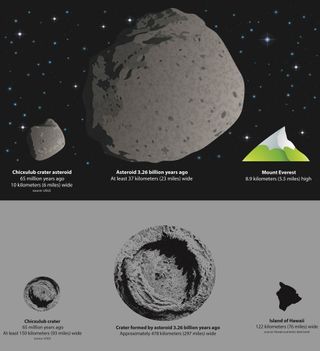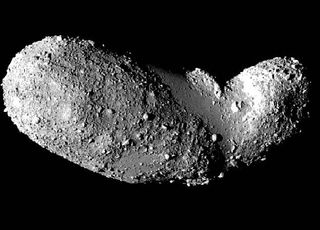Scientists have reconstructed a long-ago asteroid impact that makes the strike that wiped out the dinosaurs 65 million years ago look like a playful chuck on the chin.
The enormous collision occurred 3.26 billion years ago and involved an asteroid 23 to 36 miles (37 to 58 kilometers) across — four to six times wider than the dino-killing space rock. The impact created a crater about 300 miles (500 km) wide and generated seismic waves far more powerful than those produced by any earthquake in recorded history, researchers said.
The asteroid impact was "far larger than anything in the last billion years," Jay Melosh of Purdue University, who was not involved in the new study, said in a statement. [Wipe Out: History's Most Mysterious Extinctions]
Researchers Norman Sleep and Donald Lowe, both of Stanford University, mapped out the details of the cataclysmic strike after studying rocks in a region of South Africa known as the Barberton greenstone belt.
The space rock probably hit far away from the Barberton formation, in a location that researchers may never find. But it left its imprint on the South African rocks and on the entire Earth, disrupting the planet's crust and possibly spurring a transition from an early tectonic regime to the more modern plate-tectonic system that prevails today, researchers said.
"This is providing significant support for the idea that the impact may have been responsible for this major shift in tectonics," said UCLA geologist Frank Kyte, who was not a member of the study team.

The mammoth collision likely posed a severe challenge for life on Earth, which first evolved about 3.8 billion years ago. The sky would have filled with dust and become incredibly hot, while the upper layers of the ocean would have boiled, researchers said.
Get the Space.com Newsletter
Breaking space news, the latest updates on rocket launches, skywatching events and more!
The asteroidimpact could have wiped out a large percentage of the planet's lifeforms, vacating niches that the survivors evolved to fill.
"We are trying to understand the forces that shaped our planet early in its evolution and the environments in which life evolved," Lowe said.
While incredibly dramatic, this enormous smashup was probably far from unique. Rather, it was one of many such strikes that occurred during a period called the Late Heavy Bombardment, which began around four billion years ago and lasted for perhaps one billion years.
That bombardment period also affected other bodies in the inner solar system, blasting huge holes into Mars, Venus, Mercury and Earth's moon.
The new study has been accepted for publication in the journal Geochemistry, Geophysics, Geosystems.
Follow Mike Wall on Twitter @michaeldwall and Google+. Follow us @Spacedotcom, Facebook or Google+. Originally published on Space.com.

Join our Space Forums to keep talking space on the latest missions, night sky and more! And if you have a news tip, correction or comment, let us know at: community@space.com.

Michael Wall is a Senior Space Writer with Space.com and joined the team in 2010. He primarily covers exoplanets, spaceflight and military space, but has been known to dabble in the space art beat. His book about the search for alien life, "Out There," was published on Nov. 13, 2018. Before becoming a science writer, Michael worked as a herpetologist and wildlife biologist. He has a Ph.D. in evolutionary biology from the University of Sydney, Australia, a bachelor's degree from the University of Arizona, and a graduate certificate in science writing from the University of California, Santa Cruz. To find out what his latest project is, you can follow Michael on Twitter.










